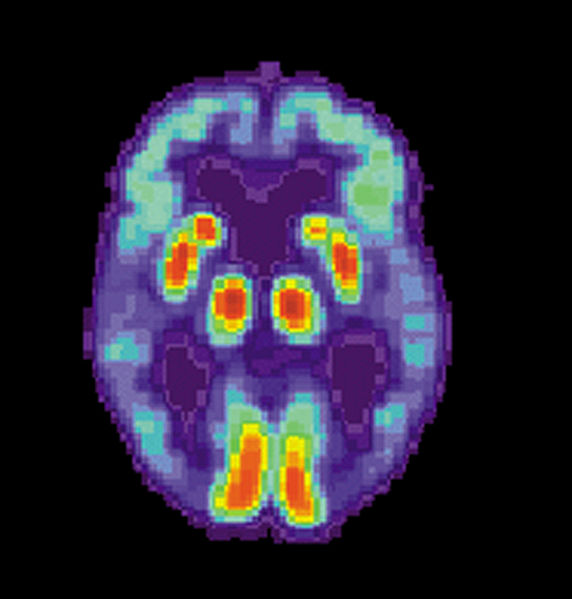Prospective Alzheimer’s drug builds new brain-cell connections
October 12, 2012
[+] PET scan of a human brain with Alzheimer’s disease (credit: US National Institute on Aging, Alzheimer’s DiseaseEducationand Referral Center/Wikimedia Commons)
Washington State University researchers have developed a new drug candidate that dramatically improves the cognitive function of rats with Alzheimer’s-like mental impairment.
Their compound, which is intended to repair brain damage that has already occurred, is a significant departure from current Alzheimer’s treatments, which either slow the process of cell death or inhibit cholinesterase, an enzyme believed to break down a key neurotransmitter involved in learning and memory development./.../
PET scan of a human brain with Alzheimer’s disease (credit: US National Institute on Aging, Alzheimer’s DiseaseEducationand Referral Center/Wikimedia Commons)
Washington State University researchers have developed a new drug candidate that dramatically improves the cognitive function of rats with Alzheimer’s-like mental impairment.
Their compound, which is intended to repair brain damage that has already occurred, is a significant departure from current Alzheimer’s treatments, which either slow the process of cell death or inhibit cholinesterase, an enzyme believed to break down a key neurotransmitter involved in learning and memory development./.../
Prospective Alzheimer’s drug builds new brain-cell connections
October 12, 2012
[+]

PET scan of a human brain with Alzheimer’s disease (credit: US National Institute on Aging, Alzheimer’s DiseaseEducationand Referral Center/Wikimedia Commons)
Washington State University researchers have developed a new drug candidate that dramatically improves the cognitive function of rats with Alzheimer’s-like mental impairment.
Their compound, which is intended to repair brain damage that has already occurred, is a significant departure from current Alzheimer’s treatments, which either slow the process of cell death or inhibit cholinesterase, an enzyme believed to break down a key neurotransmitter involved in learning and memory development./.../
Evaluation of metabolically stabilized angiotensin IV analogs as pro-cognitive/anti-dementia agents
- Alene T McCoy1,
- Caroline C Benoist2,
- John W Wright3,
- een H Kawas3,
- Jyote Bule-Ghogare3,
- Mingyan Zhu3,
- Suzanne M Appleyard3,
- Gary A Wayman3, and
- Joseph W Harding3,*
+Author Affiliations
- ↵* Corresponding author; email: hardingj@vetmed.wsu.edu
Abstract
Angiotensin IV (AngIV: VYIHPF) related peptides have long been recognized as pro-cognitive agents with potential as anti-dementia therapeutics. Their development as useful therapeutics, however, has been limited by susceptibility to metabolic degradation and physiochemical properties that make them impermeable to gut and blood-brain barriers. A previous study has demonstrated that the core structural information required to impart the pro-cognitive activity of the AngIV analog, Norleucine1-angiotensin IV (Nle1-AngIV), resides in its three N-terminal amino acids, Nle-Tyr-Ile. The goal of this project was to chemically modify this tripeptide in such a way as to enhance its metabolic stability and membrane permeability to produce a drug candidate with potential clinical utility. Initial results demonstrated that several N- and C-terminal modifications lead to dramatically improved stability while maintaining the capability to reverse scopolamine-induced deficits in Morris water maze performance and augment hippocampal synaptogenesis. Subsequent chemical modifications, which were designed to increase hydrophobicity and decrease hydrogen bonding, yielded an orally active, blood-brain barrier permeant, metabolically stabilized analog, N-hexanoic-Tyr, Ile-(6) aminohexanoic amide ( Dihexa) that exhibits excellent anti-dementia activity in the scopolamine and aged rat models and marked synaptogenic activity. These data suggest that Dihexa may have therapeutic potential as a treatment for disorders, like Alzheimer's disease, where augmented synaptic connectivity may be beneficial.
- Received August 22, 2012.
- Revision received October 5, 2012.
- Accepted October 9, 2012.
- The American Society for Pharmacology and Experimental Therapeutics
No comments:
Post a Comment